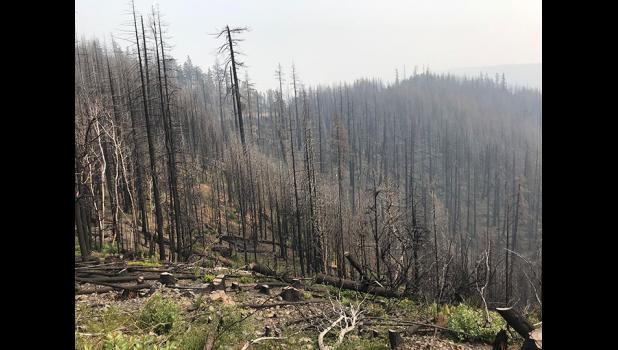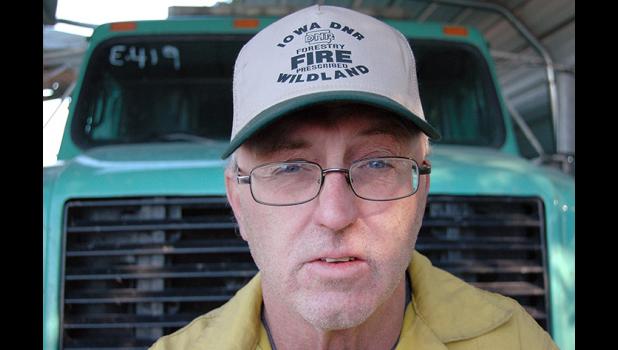Man vs. Nature
By ANDREW MCGINN
Arguably, if not for global warming, Karl Harris might never have had to defend a nudist colony from an oncoming wildfire.
Or, in more up-to-date terms, Karl Harris likely hasn’t saved his last clothing-optional resort from the effects of climate change.
Since 2000, at least 10 Western U.S. states have endured their largest fires on record — and the forecast, according to a highly publicized report on climate change issued Oct. 8 by the United Nations, doesn’t look good for Harris to attend the Iowa State Fair.
“I miss the state fair most years,” Harris explained recently.
A Greene County native and a fire specialist for the Iowa Department of Natural Resources, Harris has been tapped to help fight wildfires out West nearly every summer for the past 14 years.
The Western wildfire season is not only longer than anytime in the past, but the fires are bigger and more unpredictable — meaning more hands are needed to get them under control.
His crew one summer in Northern California managed to halt a wildfire a quarter-mile from that nudist colony.
“It’s all in a day’s work,” he quipped.
Harris, 56, who at one time served as chief of the Paton Fire Department and now farms near Bouton when he isn’t risking death in the wilds of the West, puts a recognizable face on an issue that seems so far away.
Or maybe it’s closer than we think.
On a brilliant fall morning last week, Harris was raring to hop in the combine, hoping to make up for harvesting time lost to perpetual rain and even snow.
“It’s wet,” he complained. “Nothing’s dry.”
Harris freely admits he doesn’t know what’s behind the surge in wildfires — like many people, he’s still ambivalent about the role of global warming — but science is more certain.
According to the Union of Concerned Scientists, temperatures in the Western United States the past 48 years have risen faster than the planet as a whole. Average annual temperatures out West have risen 1.9 degrees Fahrenheit since 1970 — double the pace of global warming.
That is causing winter snowpack to melt earlier, scientists say, leaving forests drier for longer.
All it takes is a lightning strike or a careless human and the result will be a fire that burns longer and hotter than before.
The recent U.N. report on global warming — a massive tome issued by the Intergovernmental Panel on Climate Change — says that even just another half-degree rise in temperatures around the world will be tempting fate.
Already, the report stated, human activity has warmed the world since pre-industrial times by about 1 degree Celsius, which has contributed to more frequent wildfires, decreases in crop yields, rising sea levels and shifts in the distribution of plant and animal species.
Harris chalks up the increased intensity of wildfires to the amount of dead trees caused by pests.
But could that, too, be a symptom of climate change?
Another half-degree increase in annual temperatures — which we could experience in as little as 12 years at the current rate, the report says — would put us at greater risk of heatwaves and more extreme weather, including heavy rain events.
What’s worse?
Limiting global warming to 1.5 degrees Celsius, the report warned, will require “rapid, far-reaching and unprecedented changes in all aspects of society.”
Harris has already witnessed this new normal firsthand, exhausting himself as an EMT in Louisiana in 2005 after Hurricane Katrina, one of the deadliest hurricanes to ever strike the United States, and clearing roads of trees in West Virginia after Hurricane Sandy roared through as a killer snow storm in 2012.
“I really like Iowa,” he said. “I can dodge tornadoes.”
It was a lightning strike that sparked a wildfire this past July in the Umpqua National Forest of Oregon, on the western slopes of the Cascade Mountains.
That’s where Harris found himself for 18 days.
The fire was finally deemed 100 percent contained just last week after consuming 54,334 acres.
All things considered, Harris has seen and experienced much worse.
“Had pretty good food. Actually had showers,” he said. “Some years, the food is terrible.”
His longest-stretch without a shower remains 13 days one year in Idaho.
Since going to work for the DNR 14 years ago, there’s hardly a Western state he hasn’t been to as engine boss of the department’s five-person, Type 3 fire engine. It takes them about two and a half days to drive to Oregon.
As soon as DNR fire personnel leave Iowa, he said, they become U.S. Forest Service firefighters.
Harris has also worked alongside firefighters from Canada, Australia and even the island of Saipan.
“You make friends from all over the world,” he said.
It’s a massive undertaking, for sure.
In 1985, wildland fires in the U.S. burned more than 2.8 million acres, and cost the Forest Service and other federal agencies more than $239 million to fight.
In 2017, more than 10 million acres burned, upping the cost for federal agencies to $2.9 billion.
A serious near miss
“They’re increasing in intensity,” Harris said of the fires they’re facing.
Adding to that intensity is the fact they find people living — and, yes, sometimes even playing volleyball in the nude — almost everywhere amid the Jeffrey pines and Douglas firs.
They call it the “wildland-urban interface.”
“It’s beautiful country,” Harris conceded. “If you’ve got the means, that’s the end goal of a lot of people.”
But according to the Forest Service, more than 46 million homes in the U.S. are at risk from wildfire.
“It seems like you’re always dealing with some man-made improvement in the forest anymore,” Harris said.
Whenever he finds people reluctant to evacuate, Harris hands them his DNR business card and asks them to stick it inside their shoe with their name and their next of kin’s name written on the back.
If they ask why, Harris answers, “So it’s easier for me to identify the body.”
They usually evacuate, he said.
There are more threats to fire crews than just unpredictable flames.
“There’s bears. And cougars,” Harris said matter-of-factly. “And the bees are terrible. Then you have people who hate the government.”
If that’s not enough, “Vietnam-style” booby traps can be found on trails leading to illegal marijuana grows, Harris said.
It’s a long way in more than just miles from the combine fires and grass fires that normally confront firefighters in rural Iowa.
“It’s quite a culture shock,” he added.
Paton resident Matt Fox, who served as the town’s assistant fire chief in the ’80s, isn’t surprised their former chief has found a way to help fight fires out West.
“It takes a certain breed of person to dedicate themselves to something like that,” Fox said. “He’s dedicated. He’s the kind of guy who’d give you the shirt off his back.”
A 1981 graduate of Paton-Churdan High School, Harris initially joined the volunteer fire department for the usual reasons.
“My friends were on it and I liked helping people,” Harris said.
Fresh from high school at the time, he quickly attained the rank of chief.
“He was a hell of a chief,” Fox said. “If you put on an air pack and went into a burning building with him, he always had your back.”
Despite being “just a kid,” Harris nevertheless transformed Paton’s fire department, updating equipment and boosting the amount of training.
“He was damn good,” Fox said. “He was always into training. We didn’t have much training before.”
For Harris, who also serves on the Bouton and Woodward fire departments, his annual excursion out West to fight fires has prepared him for virtually any scenario.
“You come back,” Harris explained, “and you can have a five-car pileup on (Highway) 141 and it’s a cakewalk compared to what happens out West.”
All of his training and experience were put to the ultimate test in 2017.
As Harris now casually puts it, “ ’Bout got killed out there last year.”
A lightning strike on July 12, 2017, sparked a fire near the Chetco River in the Rogue River-Siskiyou National Forest of southwest Oregon.
Harris and his DNR engine eventually got the call to join the fight.
All said, the Chetco Bar Fire would consume 191,125 acres of rugged beauty between July 12 and Nov. 2, and cost more than $69.8 million to suppress.
On Aug. 18, 2017, Harris and his crew were making efforts to protect what’s known as Packers Cabin — an old Forest Service cabin from the days of mule packs that campers can now rent for $40 a night — when the wind shifted.
Suddenly, in less than 10 minutes, they were cut off from their planned escape route and the rest of the task force.
Harris had been calling in bucket drops from a heavy helicopter when the pilot reported he couldn’t see where to drop the water through all the smoke.
“He said, ‘Iowa, you’re in a real bad way,’ ” Harris recalled.
Harris knew just how bad it was.
Two years before — almost to the day — Harris was at the Twisp River Fire in Washington state when the wind changed directions on firefighters there.
The Twisp River area had been experiencing an extreme drought.
Looking to make a run for it, one engine crew on Aug. 19, 2015, started downhill on a road obscured by smoke.
Three firefighters were killed when their engine went off the road.
Harris and his crew — their lungs burning and their eyes watering from the highly irritating tanoak smoke in the air — now had seconds to make a similar choice.
In the meantime, the helicopter pilot above reported likely entrapment, which brought an air tanker and a rappel ship to the scene.
Harris now notes, somewhat morbidly, that rappellers are usually only called to recover bodies.
“Everybody stayed calm,” he said, “and we worked right through it.”
The chrome knobs on the truck were so hot they couldn’t be touched without gloves, but Harris decided they had few options but to drive their way out.
“We drove through a tunnel of fire to get away from it,” he said.
It was the first and only time his engine’s windshield-mounted GPS lost its signal, he said.
They ended up having to spend the night in the relative safety of Packers Cabin, the incident going on record as a “serious near miss.”
- Log in to post comments





